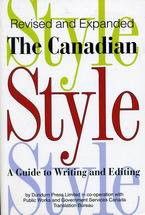
| Home News Releases | Calendar Contact |
Sources Bookshelf

The Canadian Style
A Guide to Writing and Editing
Publisher: Dundurn Press Ltd. in co-operation with Public Works & Government Services, Toronto, CanadaYear Published: 1997
Pages: 312 pp ISBN: 1-55002-276-8
Library of Congress Number: PN147.C36 Dewey: 808`.02
Please see our media profile in Sources:
Sources Select Resources
Whether you need to improve your writing and editing skills, or need a supplementary guide to increase your understanding of the Canadian English language, The Canadian Style: A Guide to Writing and Editing will be the expert fit. Some scholars would insist that you should read a lot of books and/or take a course on writing to learn how, but you could easily sharpen your skills with this one book. If you have lots of time on your hands to read, don't let me deter you, but I am in praise of all writing guides that are time savers, easy to use and non-exhaustive in content.
An impressive component of this guide, is its inclusion of chapter fourteen: #Elimination of Stereotyping in Written Communications.# Informed by the 1982 Government of Canada document entitled Elimination of Sexual Stereotyping, and the 1990 Fair Communication Practises, this guide updates the reader on how written communication should reflect principles of equality. Firstly, it suggests the reader eliminate the use of male pronouns to signify the non-specific #he or she,# and eliminate the use of feminine or masculine pronouns to characterize animals, events, ships, cars etc. Secondly, this guide touches on the identification of groups. #Be aware of the current self-identification preferences of racial and cultural groups in Canada,# is the best suggestion, since the names often change with each wave of liberation movements. Though a short chapter, it was a fair attempt to begin correcting stereotypes and biases which constitute barriers for certain individuals across Canada. And why not begin in a medium than has a wide reach.
Of equal importance, this guide points to the need for achieving clarity within written communication. Reiterated in many ways thorough the chapters, it makes an example of itself and communicates this point clearly. Clarity is especially important for documents that are used to inform the public about government policies, programs and services. Consequently, communication professionals are called to adhere to this guide. Written in co-operation with the Public Works and Government Services Canada Translation Bureau, a standard has been set.
The Canadian Style suggests the first step in communicating clear ideas is to use plain language, without jargon or expressions. Then, consider your audience. Ask yourself, who are you writing for, and write for their ears. Next, write clearly and concisely. All these elements calls to mind the K.I.S.S. (keep it simple, stupid) motto that was drilled into me in grade school. Many teachers might have had a similar guide on their bookshelf as a reference to build catchy sayings for their students to remember. And if they didn't they should get their hands on this one. Remember the jingle #i before e except after c or when sounded as a as in neighbour and weigh.# The Canadian Style did not miss including it, to outline one of the most common spelling mistakes. Try repeating the jingle to yourself, once or twice, and there will be no mistaking how to spell receive again.
How is your use of punctuation? The Canadian Style indicates that business and personal correspondence go either of two ways with the usage of punctuation; over usage or under usage. However, both can have the same confusing affect on the reader. And in that situation it suggests the sure test is again, clarity. If the punctuation within a sentence does not result in creating crisp ideas, then it needs to be rewritten with less punctuation. This is where using commas is the default punctuation. Yet, do not be afraid of using all the different types; ellipsis points, commas, semicolons, colons, parenthesis, square brackets or apostrophes. This guide will help you graduate from one to the other with ease.
Lastly, The Canadian Style would have been incomplete if it did not include French typographical rules. Specific to Canada, a lot of #English documents contain French-language words, phrases, names, titles,# etc. And it is significant that they are presented correctly. Even if your French is poor, the reader can understand the basics of writing a document with French content through this guide. However, the basics are all that is given. So consider a French course if your skills need to encompass more than the use of acronyms, abbreviations and an overview of accurate punctuation.
As a testament to the usefulness of The Canadian Style, I briefly found myself double checking with this guide as I wrote, fearing it, a stern figure that would eventually point out my mistakes (teacher like). However, it turned out to be more of a close friend. One that will always be within reach to help steer you from common mistakes. Every writer needs such an aid, especially if it means the liberation of one's writing style.
© Sources 2023. The information provided is copyright and may not be reproduced in any form or by any means (whether electronic, mechanical or photographic), or stored in an electronic retrieval system, without written permission of the publisher.